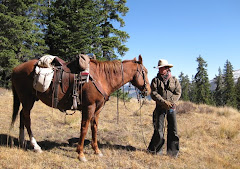 As we head out again to the high country with our horses, this is the season to be amassing notes, photos, information and ideas to share with you at a later date and a slower time. And stories, including Floyd Stories… Ah, the ebb and flow of life. It’s flowing now. Lots of fun, and never enough time to do all we wish to accomplish on any given day. A good feeling, to have so much you want to do, you enjoy doing, you wish you could do…
As we head out again to the high country with our horses, this is the season to be amassing notes, photos, information and ideas to share with you at a later date and a slower time. And stories, including Floyd Stories… Ah, the ebb and flow of life. It’s flowing now. Lots of fun, and never enough time to do all we wish to accomplish on any given day. A good feeling, to have so much you want to do, you enjoy doing, you wish you could do…In the meanwhile, a brief set of notes to share with you on horse packing. These on the actual how-to on the trail.
First of all, it sure helps if your riding horse or mule neck reins and doesn’t mind a rope under the tail. Most horses (and almost all mules) are surprisingly undisturbed by a rope rubbing under their back end and will completely ignore this, or perhaps clamp down their tail briefly. I don’t think I would like it much, so the few that do over react, and a few will, I give them time; they’ll accept it eventually.
Next, if you are leading more than one horse or mule in a pack string, take care to tie them together safely. We use a “pigging string,” a piece of bailing twine looped over the front brace of the cross bars in the pack saddle before packing the horse, and hanging out the back end of the pack over the horses rigging along their back. The lead rope of the following horse is then tied onto the pigging string. (This works well too for leading a group of saddle horses – just loop the pigging string over and under the saddle horn and be sure the cinches are tight.)
The pigging string serves as a release point in an emergency, such as a horse slipping down trail. Better to allow a break point than lose your whole string. The horse’s safety matters to me. I figure I have no right being out there working with my stock if I can’t care for them in a safe and sound manner. Pack extra bailing twine. It can snap en route. Replace it as needed. Anyway, you all know how many other uses you’ll find for string in camp if you don’t use it all getting into camp…
We tend to tie the lead rope on long enough that the following horses can put their head down to drink at creek crossings if need be. We’re often out there for long hours, and our stock work hard. For short trips, you may consider tying shorter – not so close that the horse will ride up on the horse in front, but not so long that the horse can put his head down and graze as he moseys down the trail.
Finally, the most important part is caring for your stock on the trail. I once read that a truly good packer rides looking backwards half the time. I strive to do this. I try to gently hold my riding horse up as needed at creek crossings, bridges, rocks, and other obstacles in the trail. Make sure the string all find their footing and safely cross. Keep an eye on the stock to make sure they are not being dragged along or pulling back, and that they are staying in line. The order of your stock in the pack string is essential. A bossier horse will work great in the lead to keep others in line behind, unless he or she kicks, then that one needs to be at the end of the line… unless he or she bites. Get to know your stock. Find the order that works best for them. Allow them to be happy and comfortable. I don’t want my horses grumbling and uncomfortable in the pack string. It is work, but not a bad job. They more content the stock is doing their job, the easier my job is, of course.





